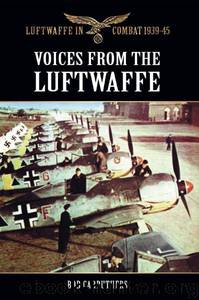Voices from the Luftwaffe (Luftwaffe in Combat 1939-45) by Bob Carruthers

Author:Bob Carruthers [Carruthers, Bob]
Language: eng
Format: epub
Tags: HISTORY / Military / Aviation
ISBN: 9781473844452
Publisher: Pen and Sword
Published: 2013-01-06T22:00:00+00:00
The Ju-52 was the workhorse of the Luftwaffe for logistics transport and logistics missions. The aircraft was easy to maintain and carried a reasonable payload. It could take great punishment, which was fortunate, as the machine was sluggish and in consequence was easy prey for enemy fighters. First introduced into service in 1931, over 5000 of these rugged machines saw service with the Luftwaffe in every theatre of war.
‘In one street, about a dozen firemen, with hoses and fire-pumps, had just managed to extinguish one fire. They told us factories had been hit. It wasn’t too easy to breathe. Above the glare, we could see the curtain of smoke and above that two balloons.
‘Suddenly, we heard a whirring, rushing sound. ‘That’s a bomb’ someone shouted. ‘Fall flat!’ We flung ourselves in the gutter, in a sort of human chain. A few moments passed. Afterwards, we took shelter in a garage. When the activity overhead died down, we came out again. What we had seen before was nothing to what we saw now.
‘The whole air was a bright blaze of gold, with those two balloons still floating above. We shouted for our taxi man. When he arrived, he said he had been blown to the ground by a bomb. Just as we started off again in the taxi, we heard first a rushing, then a heavy explosion and a brilliant firework display in the road directly in our path. A bomb had blocked the road.
‘Later, I talked with a woman who drove in a car over London Bridge and back over Tower Bridge during the evening. She said that nothing moved her so much as the sight of the Tower of London. ‘It stood there squat and solid and contemptuous, with the whole sky on fire behind it,’ she said. ‘It symbolised the whole of our history. It will take a good deal more than Hitler to shake us.’
Defiant attitudes like this were bad news for Hermann Goering. He had assumed that the British could be terrorised into submission by bombing and strafing. Gripped by this delusion, he had made a serious blunder in sending his Luftwaffe to attack Britain’s cities while neglecting to press home the offensive against the British Fighter Command.
Goering’s blunders multiplied when he dispatched bombers to assault cities as far apart as Swansea, Aberdeen and Belfast. On one raid, attempting to safeguard the dispersed bomber streams, the Luftwaffe lost twenty-four fighters to the RAF’s fourteen. The effect of the Luftwaffe offensive was also blunted by poor intelligence gathering. The wrong airfields and factories were targeted.
As the Battle of Britain progressed, the loss of RAF fighters was heavy, but the loss to the Luftwaffe was heavier. On 15th July, fifty German aircraft were destroyed in one day. Between 13th and 18th August, three hundred and fifty German aircraft were lost. The RAF lost one hundred and seventy.
In Britain, the summer of 1940 was bright, sunny and warm, the perfect flying weather, and thousands of people in the south
Download
This site does not store any files on its server. We only index and link to content provided by other sites. Please contact the content providers to delete copyright contents if any and email us, we'll remove relevant links or contents immediately.
| Afghan & Iraq Wars | American Civil War |
| American Revolution | Vietnam War |
| World War I | World War II |
Waking Up in Heaven: A True Story of Brokenness, Heaven, and Life Again by McVea Crystal & Tresniowski Alex(37671)
Empire of the Sikhs by Patwant Singh(22974)
We're Going to Need More Wine by Gabrielle Union(18967)
Hans Sturm: A Soldier's Odyssey on the Eastern Front by Gordon Williamson(18483)
Leonardo da Vinci by Walter Isaacson(13181)
The Radium Girls by Kate Moore(11921)
Tools of Titans by Timothy Ferriss(8218)
Educated by Tara Westover(7941)
How to Be a Bawse: A Guide to Conquering Life by Lilly Singh(7391)
Permanent Record by Edward Snowden(5737)
The Last Black Unicorn by Tiffany Haddish(5558)
The Rise and Fall of Senator Joe McCarthy by James Cross Giblin(5228)
Promise Me, Dad by Joe Biden(5087)
The Wind in My Hair by Masih Alinejad(5033)
A Higher Loyalty: Truth, Lies, and Leadership by James Comey(4843)
The Crown by Robert Lacey(4723)
The Iron Duke by The Iron Duke(4291)
Joan of Arc by Mary Gordon(4013)
Stalin by Stephen Kotkin(3875)
